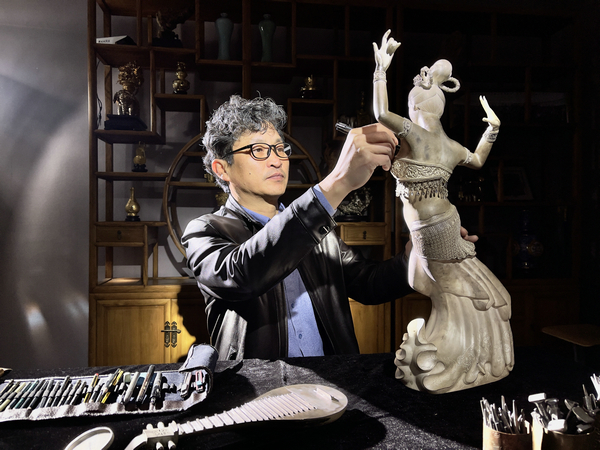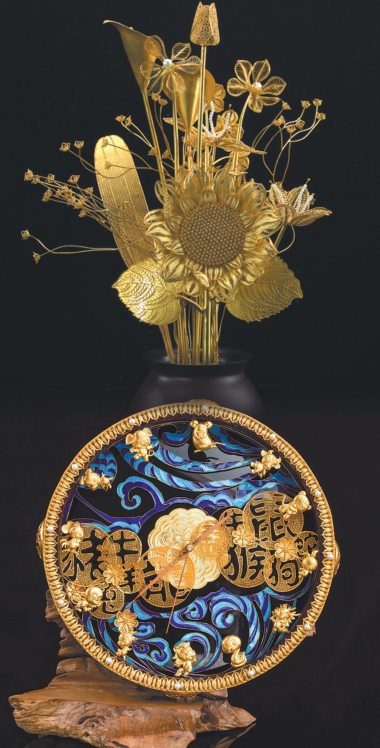
Yuan Changjun, filigree inlay artist, works on a silver statue of a celestial maiden at his studio in Beijing. CHINA DAILY
Walking into Yuan Changjun's studio in northwest Beijing's Changping district, a large silver statue of a celestial maiden playing a reversed pipa, a four-stringed Chinese lute, in a flying motion catches visitors' attention.
"The statue was inspired by the iconic Dunhuang murals in Gansu province. It's not a direct replication, but a reinterpretation," says the man in his 50s who has practiced filigree inlay for over three decades.
"The face is modern — contours, expression, and hairstyle, which speaks today's visual language," he adds.
Using silver as the base material for the figure, Yuan began the creative process with one of "three core techniques" — zhitai (forming the base).
"This involves shaping the figure's basic form through forging and engraving, establishing the character's pose and expression," he explains.
To convey the flowing, graceful movement of its skirt, Yuan employed huasi (filigree) — the delicate weaving of gold or silver threads.
"Every line and texture of the skirt is engraved to evoke the lightness and translucency of silk," he notes.
One of the celebrated eight imperial crafts, including jade carving and cloisonne of ancient China, filigree inlay dates back over 2,000 years to the Han Dynasty (206 BC-AD 220). This intricate craft peaked during the Ming (1368-1644) and Qing (1644-1911) dynasties, often used to create opulent jewelry, ceremonial ornaments and royal artifacts.
The artistic technique involves twisting threads of pure gold or silver as fine as hair into intricate motifs — floral scrolls, auspicious symbols or animal forms — then soldering them onto a base and embellishing them with precious stones, pearls, enamel, or kingfisher feathers.
The process demands extreme precision, patience, and craftsmanship, with some pieces taking months or even years to complete.
Yuan notes that many people misunderstand filigree inlay as simply a decorative patterning. In reality, it encompasses several major technical components and represents one of the most complex forms of traditional craftsmanship.
"Many of our historical gold and silver artifacts, and certain bronze objects, fall under the umbrella of filigree inlay," Yuan explains.
Beyond zhitai and huasi, zanke (fine engraving done with a chisel) is the third core technique.
"Each of these can stand alone in creating a complete artwork," he says.
For instance, many traditional teapots or wine vessels are made using only zhitai, while historical examples like gold crown from the Ming Dynasty are purely huasi, he says.
One of his decorative screen works is currently on display at the China National Arts and Crafts Museum, which utilizes zanke to depict the majesty of the Great Wall in vivid details.
Adding to the richness of his current celestial maiden piece is the application of shaolan (blue-enamel firing technique), another important element of filigree inlay.
Yuan uses this technique to bring vibrant colors to the otherwise monochromatic silver base.
While many people associate enamel with cloisonne, Yuan clarifies that his method uses silver as the base and a different type of high-temperature glaze.
By combining wire outlining (qiasi), filigree filling, and colored enamel, he brings to life the intricate patterns and textures of the celestial figure's clothing.
Yuan holds many distinguished titles under his belt — traditional Chinese arts and crafts master and third-generation inheritor of filigree inlay, designated as a national intangible cultural heritage in 2008.
His exquisite works have won multiple international awards, including the United Nations award for promoting intangible cultural heritage in October.
Over the years, he has restored and replicated hundreds of cultural relics for nearly 100 museums across China. Among his most celebrated achievements, the filigree-inlaid clutch bags and brooches he and his team created served as national gifts for the 2014 APEC Summit in Beijing.
A native of the capital city's northeast Miyun district, Yuan developed a love for art during his school years.
In the early 1990s, he joined a Changping arts and crafts factory, drawn by the sheer beauty of its products and the dream of becoming a designer who could draw every day.
Since the factory specialized in filigree inlay, Yuan cut his teeth on every step of the intricate production process, staying two or three hours after his shift ended to refine his skills.
During training in engraving metal, he once struck his left index finger with a small hammer. Blood streamed down, but he continued hammering, then another blow landed on the same wound, he recalls.
To this day, he bears a small scar on that finger. His persistence paid off, and he soon became a master engraver.

Yuan's filigree works range from a bouquet of flowers (top) to a clock (above). CHINA DAILY
Yuan considers filigree inlay an art of metal and fire.
Apart from the core techniques, the process involves more than 10 meticulous steps, including wire drawing, soldering, and stacking, each requiring careful precision.
"Take wire drawing, for example. One gram of gold can be drawn into a wire 2 kilometers long," he says.
Those thin wires require extraordinary soldering skill, since strands as fine as human hair must be joined seamlessly to create the intricate patterns.
A slight miscalculation in flame control can undo hours of work by melting or breaking the wire.
"All the welding must be invisible to the eye — achieved purely through handwork and experience," Yuan emphasizes.
For years, Yuan has taught at the Beijing Arts and Crafts Technician College, helping to train versatile artisans capable of mastering the full range of filigree inlay skills. His mission is clear: to ensure this extraordinary craft is never lost, and to raise a new generation of masters to carry it forward.
Huo Kaijie, Yuan's apprentice, still remembers the greatest challenge he faced at the beginning. He wasn't just mastering the intricate techniques, but learning to make cold metal breathe with life.
"I remember my hands shaking during my first soldering attempt," he recalls.
Yuan patiently guided him through each movement, transforming mechanical processes into muscle memory through countless repetitions.
"He taught me that craftsmanship isn't about rigid perfection, but developing a dialogue with the material," Huo says.
Now a teacher himself, Huo emphasizes this wisdom to skeptical students who question the relevance of handwork in the age of 3D printing.
"I show them state gifts crafted by hand so they can feel the difference," he explains, adding "Machines can replicate precision, but never the human touch".
In recent years, the art form has made a strong comeback.
Filigree inlay craftsmanship is gaining popularity in the premium market for its exquisite artistry and cultural depth, with growing sales in custom wedding jewelry and collectible art pieces, Huo observes.
He suggests that more cultural creative products with lower prices be developed to further tap market potential.
Yuan attributes the growing popularity of his trade to innovation — not merely replicating ancient forms, but pushing the boundaries of traditional craftsmanship while embracing contemporary aesthetics.
Although the celestial maiden remains unfinished, its intricate details are already taking shape, each aimed at achieving a lifelike effect.
This pursuit of realism reminds Yuan of a state gift he once crafted: a fruit bowl that appeared to hold a delicate silk scarf, yet was made entirely of metal.
"One official even tried to lift the scarf, thinking it was real," Yuan recalls with a smile.
"That's the kind of illusion we strive for — capturing the texture of silk in metal."
 Editor:Qiu Xiaochen
Editor:Qiu Xiaochen